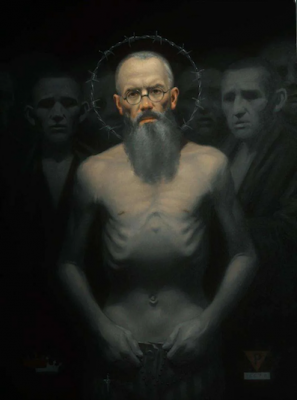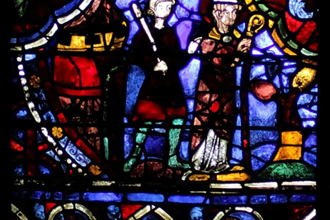Gospel in Art: Feast of Saint Maximilian Kolbe

Saint Maximilian Kolbe, Martyr of Charity, Painted by Neilson Carlin © Neilson Carlin, all rights reserved
Source: Christian Art
Gospel of 14 August 2024
Matthew 18:15-20
Jesus said to his disciples: 'If your brother does something wrong, go and have it out with him alone, between your two selves. If he listens to you, you have won back your brother. If he does not listen, take one or two others along with you: the evidence of two or three witnesses is required to sustain any charge. But if he refuses to listen to these, report it to the community; and if he refuses to listen to the community, treat him like a pagan or a tax collector.
'I tell you solemnly, whatever you bind on earth shall be considered bound in heaven; whatever you loose on earth shall be considered loosed in heaven.
'I tell you solemnly once again, if two of you on earth agree to ask anything at all, it will be granted to you by my Father in heaven. For where two or three meet in my name, I shall be there with them
Reflection on the painting
The story of Maximilian Kolbe, whom we are celebrating today, stands as one of the most heroic tales from the Second World War. Kolbe sacrificed his life to save a fellow prisoner, a man with a family waiting for him. Although Kolbe, a celibate priest without a family, undoubtedly valued his own life, he chose to give it up so that the other man could return to his loved ones. Jesus often describes himself as the good shepherd who lays down his life for his sheep. Jesus, too, faced death at a young age, at thirty-three, yet he willingly embraced it so that others might live. His love for us was so profound that he was prepared to die for us.
Saint Maximilian Kolbe (born Raymund Kolbe) was a Polish Conventual Franciscan Friar. During the German occupation of Poland, he remained at Niepokalanów a monastery which helped to hide, feed and clothe 3,000 Polish refugees (of whom approximately 1,500 were Jews). In 1941, their newspaper 'The Knight of the Immaculate"' offered strong criticism of the Nazis. That same year Maximilian was arrested by the Gestapo for hiding Jewish people and sent to Auschwitz, where in the most horrific of settings he continued to work as a priest and offer solace to fellow inmates.
I will leave you with the words of a letter which he wrote on 15 June 1941 to his mother, telling her not to worry about him:
"Dear Mama, At the end of the month of May I was transferred to the camp of Auschwitz.
Everything is well in my regard. Be tranquil about me and about my health, because the good God is everywhere and provides for everything with love. It would be well that you do not write to me until you will have received other news from me, because I do not know how long I will stay here.
Cordial greetings and kisses, affectionately. Raymund."
...two months later Maximilian died, on 14 August 1941, with an injection of carbolic acid. Our striking painting by American artist Neilson Carlin depicts Kolbe as saint in Auschwitz featuring a barbed wire halo.
Saint Maximilian Kolbe. Pray for us.
LINKS
Gospel in Art: https://christian.art/
Today's Reflection: https://christian.art/daily-gospel-reading/matthew-18-15-20-2024/


















